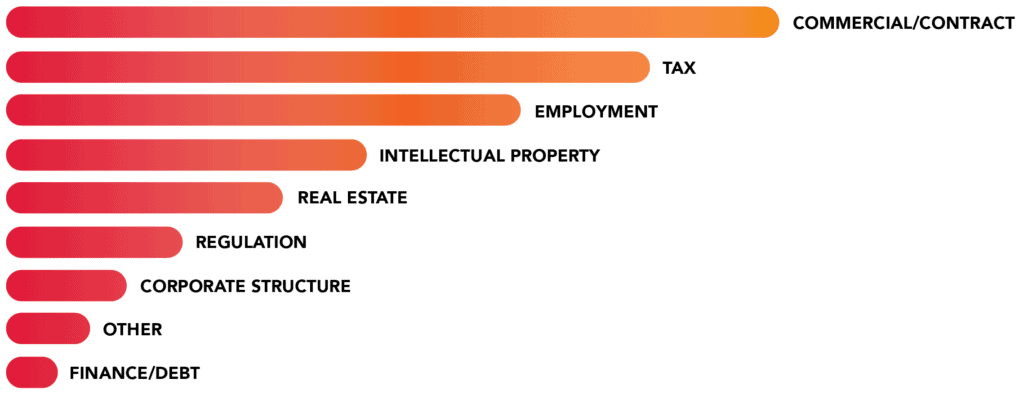
Much of the legal industry buzz is devoted to large corporate clients with robust legal departments – but this disproportionate share of voice does not reflect the state of American business, nor the state of many law firms’ client base.
Indeed, the average revenue for a Corporate Legal Operations Consortium member is $18.8 billion. (Billion, with a B.) The average CLOC company has a legal department headcount of 104; 95 percent of small businesses have no internal legal resources whatsoever.
But nationwide, the 30.2 million small businesses employ 47.5 percent of the country’s workforce and comprise 44 percent of economic activity. The small business sector brings considerable opportunity for savvy law firms – but it’s essential for lawyers to understand how the wants, needs and pressures of these companies differ from those of the corporate behemoths.
While the particulars may vary, a study by Kingston University, The Legal Needs of Small Business, provides critical insight. Researchers surveyed more than 10,000 individuals in organizations employing 50 or fewer people. Their industries ranged from agriculture to wholesale/retail; they covered a span of years in business, a mix of B-to-B and B-to-C, and both profitable and pre-profit enterprises.
KEY FINDINGS
Number of Legal Problems. The average company reported 10 legal problems per year, or a little less than one per month.
Type of Legal Problems. More than half of these problems stemmed from commercial/contract issues or taxes:
- Commercial/Contract – 37.5 percent
- Tax – 22 percent
- Employment – 14.5 percent
- Intellectual Property – 8.8 percent
- Real Estate – 7.1 percent
- Regulation – 4.5 percent
- Corporate Structure – 2.8 percent
- Finance/Debt – 1.1 percent
- Other – 1.8 percent
Turning Points for Types of Legal Problems. In one bit of fascinating data, the researchers identified the “turning points” for different types of legal problems – the size at which an organization became likely to face a certain kind of issue:
- Intellectual Property – 46 employees
- Corporate Structure – 34 employees
- Regulation – 31 employees
- Employment – 29 employees
- Commercial/Contract – 27 employees
- Tax – 26 employees
- Finance/Debt – 25 employees
- Real Estate – 24 employees
The Effect of the Legal Problem on the Business. Legal issues can have major impact on a small business. Among the results:
- Loss of income – 25.6 percent
- Loss of customer or contract – 9.2 percent
- Additional costs – 8.8 percent
- Inability to complete scheduled work – 8.7 percent
- Damage to reputation – 8 percent
- Damage to relationship with another business – 7.4 percent
- Inability to take on new work – 5.2 percent
- Damage to property – 1.9 percent
- Change in ownership/structure of the business – 1.9 percent
- Loss of employees (other than through dismissal) – 1.8 percent
- Cease in trading – 1.8 percent
The Effect of the Legal Problem on People. Small business is inherently personal; legal issues hit harder when they threaten your livelihood or your family’s legacy. Sixteen percent of respondents said that in the wake of a legal problem, they felt stress-related illness; five percent said they felt ill physically; four percent had a mental health issue; and 20 percent felt any combination of these.
Problem Solving. When asked how they tried to handle their most recent problem, more than half – 52 percent – said they worked entirely on their own. It’s worth noting that 23.4 percent used an independent advisor … but 16.8 percent turned to friends or family members, despite rating their friends and family’s legal and professional knowledge only “adequate” or worse. Nine percent of those who turned to friends and family admitted they had “no knowledge at all.”
Meanwhile, 21.5 percent used the Internet to find contact details; 21.3 percent used the Internet to find advice; and 15.1 percent used the Internet to research their legal position.
Choice of Legal Provider. The most common reasons for choosing a legal services provider:
- Reputation – 30.1 percent
- Specialty – 24.5 percent
- Previous use – 24.4 percent
- Cost – 15.7 percent
- Referred by friends or family – 9.9 percent
- Convenience – 9.8 percent
- Friends or family believed to have relevant expertise – 9.4 percent
- Accountant referral – 8.6 percent
- Trade organization referral – 8.4 percent
- Speed of delivery – 7.6 percent
Attitudes on Lawyer Fees. When asked their reaction to the statement “Lawyers provide a cost-effective means to resolve legal issues,” only 13.4 percent agreed. Nearly half, 47.1 percent, disagreed, with 15.3 percent disagreeing strongly.
Attitudes on Lawyers as a “Last Resort.” When asked their reaction to the statement “I only use a legal services provider to solve business problems as a last resort,” 49.9 percent agreed; only 14.1 percent disagreed, with 6 percent disagreeing strongly.
WHAT THIS MEANS FOR LAWYERS
Keep in mind that nearly half of small business owners view lawyers as a last resort – and that despite legal problems making them physically ill, they are almost as likely to ask friends and family members to solve an issue than they are to engage an independent resource.
The traditional way of doing business is not working for these entrepreneurs. It’s time to reimagine the model, and adjust our legal marketing along with it. The “Four Ps” of marketing are a good start:
- Product: Instead of intimidating hourly rates that discourage proactive calls or preventive medicine, consider packages that address common small business needs at a predictable price. (Or consider giving this pro bono; Spencer Fane’s STARTUP Lab is a powerful example.) Such arrangements can be loss leaders, as these clients will have more positive associations with the firm, develop relationships there, and be more likely to stay as they grow.
- Price: Beyond discounts, how can you make your services more palatable for a startup or small business? Flat fees can provide the budget predictability and calm billable-hour trepidation, and business contingency litigation can even the playing field in a David-vs.-Goliath dispute.
- Place: Recall that business owners go online to find legal advice, research their options and scout contact details. Make sure you are networking effectively online: Position yourself to be one of the resources they find while Googling.
- Promotion: The top two selection criteria for lawyers are reputation and specialty, far exceeding factors like cost and convenience. Note that it’s “specialty,” not “general mediocrity at everything”; whether you are working in a full-service firm or marketing a niche law firm, lean hard into what you do better than anyone. Make sure your attorney bio conveys your specific expertise, and use the four types of marketing evidence on your website to show you are a safe choice.
The authors of the Kingston University study repeatedly stress the need for greater communication between the legal industry and small business, and we wholeheartedly agree. For this messaging to be effective – and for lawyers to overcome their current position as “unknown and distant” – this messaging must be targeted, authentic and relevant to entrepreneurs.
One-size-fits-all marketing so often results in ill-fitting extra-extra-large branding; this will not appeal to your prospects who need an extra-small.

